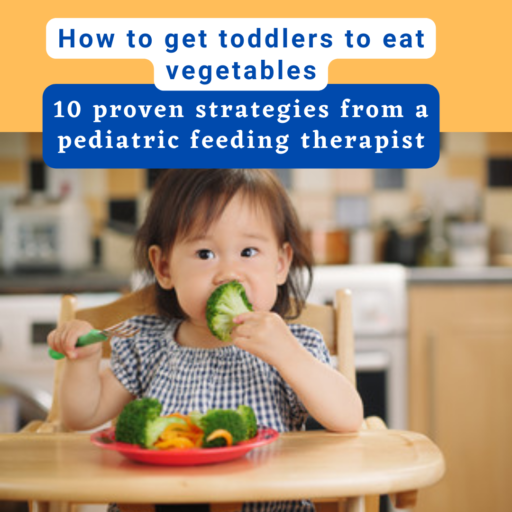Are you ready to end mealtime battles once and for all and find out how to get toddlers to eat vegetables? After nearly two years of providing feeding therapy to toddlers through preteens as an occupational therapist and taking continuing education courses by Jessica Hunt, OTR/L and Susan Roberts, OTR/L, I have quite an arsenal of tips and tricks to share.
Firstly, if you’re getting discouraged, keep trying! A 2018 study in the Journal of American Clinical Nutrition concluded that it can take over 30 repeated exposures before a child enjoys a flavor. It can take patience, but try your best to keep it light and be persistent, as attempting to force food will only lead to a negative experience for both caregivers and children. Getting toddlers to eat vegetables can be struggle, but with these tools, it can become a thing of the past.
- 1. Cook and bake vegetables so they are sweet, “dressed up” as familiar foods, or “hidden” in kid-friendly dishes.
- 2. Use positive language around trying new foods and your child’s food habits.
- 3. Implement these mealtime strategies
- 4. Know your mealtime roles
- 5. Get kids involved through the Rainbow Stages of Mealtime Participation
- 6. Use Food Chaining to determine which foods to introduce in which order.
- 7. Outside of mealtime, use the Steps to Eating and Clock Method visuals.
- 8. Read books and watch videos about trying new foods.
- 9. Let them earn creative rewards
- 10. Most importantly: Play with foods!
- How to get toddlers to eat vegetables with 10 proven strategies
1. Cook and bake vegetables so they are sweet, “dressed up” as familiar foods, or “hidden” in kid-friendly dishes.
Sweeten vegetables.

For example, try roasted brussels sprouts with maple syrup and balsamic glaze, roasted eggplant in hoisin sauce, and maple cinnamon roasted carrots.
Dress up your veggies as familiar and kid–friendly foods.

For example, zucchini fries; cauliflower pizza crust; kale chips; corn bread; tomato soup; vegan mac ‘n cheese made with carrots; cauliflower alfredo; “cheesy” broccoli soups, pastas, fritters and more; creamy zucchini pasta sauce; and creamy soups with cauliflower blended in. Try using boxed pureed veggie soups, too. You can pour it over noodles, rice, couscous, or barley as a sauce. Serve veggies raw, sliced thin and small (carrots, zucchini, green beans, celery, etc.) with a dip like peanut butter, hummus, guacamole etc.
Incorporate them into familiar and sweet dishes.

Recipes that include vegetables in familiar foods (“nutritional swaps”) are a great way to expose their palates to these flavors without having to fight with them over trying it. Try “healthified” desserts and smoothies made with vegetables, such as spinach blueberry smoothies, sweet potato Reese’s mousse, zucchini muffins, carrot orange smoothies, beet strawberry smoothies, avocado mousse, sweet potato brownies, and carrot apple muffins.
2. Use positive language around trying new foods and your child’s food habits.

Avoid saying things like, “(So-and-so) never eats this” or “So-and-so doesn’t like these.” Keep it positive! In addition, try these tips:
Rename vegetables with silly, fun labels

“X-Ray Vision Carrots,” “Tiny Tasty Tree Tops” (broccoli)” or “Silly Dilly Green Beans.” Try “planting” the vegetables in a toy garden with signs labeled with these silly names, then encouraging your child to engage in the steps to eating (kiss, lick, bite and spit out, and then chew and swallow the vegetable). Simply giving vegetables another name may encourage kids to try them. Although these studies are contested, it’s worth giving it a try.
Talk about the “superpowers” of eating the rainbow
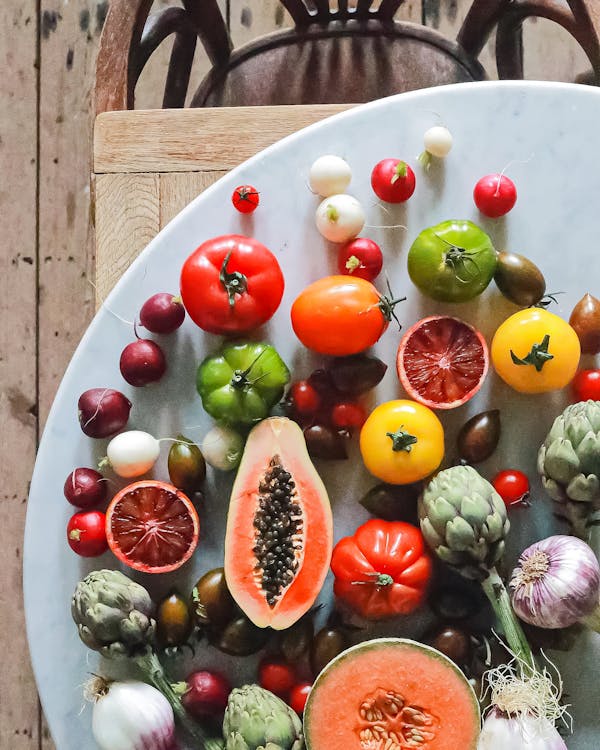
Talk with your child about how eating the rainbow in vegetables gives your body “superpowers.” For example, red and white foods support heart health and memory, orange foods support eye health, green foods help keep you from getting sick, blue and purple foods support memory.
Keep it light-hearted
If you’re pushing, you’re creating more of a negative association with feeding. Try, “Let’s go play at the table.” Kids will be more willing to come to the table if you don’t always have the expectation that they’ll eat something. They might end up trying it while you’re playing with it.
Change the dynamic

To change the dynamic, have them feed you a food instead. Make them laugh by making a bigger fit than they make. Then, let them succeed in feeding it to you. Say, “Delicious!!” and rip it out of their hands. Run away and they’ll likely chase you down to grab the food. Now, you’ve changed the energy dynamic of that food. It’s suddenly something they wanted.
Save the encouragement for after trying it, not before
We tend to accidentally reinforce NOT trying the food/doing the behavior more than DOING it. When they’re not doing it, we tend to become cheerleaders and give a ton of encouragement, then they do it and we say, “Yay good job” and that’s it. They just got more reinforcement from not doing it than doing it. Ask them what to do and then wait.
Use descriptive language
Help your child get curious about the food and explore it. For instance, you could say, “Let’s use your eyes – how big is it? What shape is it? What color is it? Let’s use your fingers! I wonder what’s inside. Let’s take a look. How does it feel? Is it smooth or bumpy? Wet or dry? Cold, room temp or hot?” For example, when introducing broccoli, try ideas like these: “Let’s give this monster a haircut and nibble off the top! We could use it as a paintbrush. Do you think it will turn my tongue green?”
3. Implement these mealtime strategies

Family-style meals
Before you start family-style eating, talk about it with your kids(s). Generally, by two years old they are able to participate. Go over these “rules”:
- Everyone serves themselves some of EVERYTHING on the table.
- Take as little as you want (even one piece). Don’t take too much because you can always come back for more.
- You don’t have to eat or even try everything, but some needs to go on your plate.
Vary your mealtime environment

Think picnics with stuffed animals, on the floor, at a picnic table, on a bench, in a fort, in a tent – whatever it takes! Change the location of mealtime to change the dynamic.
Have the veggies ready first!
Having veggies out for easy snacking and before other food is ready makes kids more likely to munch on them.
Always offer at least one food the child consistently eats.
This way, the child has the choice to interact with the non-preferred food, but they also have another comfortable and safe food option. By doing this, the child does not feel forced to eat something new unless they choose to and feels safe that they have a “comfortable” food option in case they do not like the new food. Offer small portions to avoid overwhelm. Ice cube or muffin trays work well. Additionally, try not to offer the same foods daily. Rotate foods so the same food is only offered 1-2 times a week.
Positioning: 90-90-90 Rule
If a child is comfortably and securely positioned, they will be more likely to stay at the table longer for mealtime. Their hips, knees and ankles should all be at 90 degrees. In their mealtime chair, they may need foot support and lateral supports (e.g. rolled up towels) on the sides of the chair at their hips to avoid compromising resources available for oral motor skills.
4. Know your mealtime roles

Child’s role: decide whether to eat and how much to eat.
Leave it up to your children to decide if they will eat those foods and how much they want to eat. As long as at least one food they’ll eat is present, they can fill up on that one food. To measure how much they should be consuming for any given portion of food, use the child’s hand, one tablespoon of food for each year of age, or let your child choose the amount.
Caregivers’ role: prepare ONE meal for everyone in the family.
Pass around food to everyone at the table, presenting the preferred food last to your child. Establish the rule that what you see on the table is what you get and it comes at a certain time. The kitchen is closed after lunch/dinner is over. If your child protests, say, “It’s okay to be hungry, we’ll eat soon.”
The power of social eating
Eating with others could be one of the most important techniques you could implement to get a child to increase the variety in his or her diet. Because of mirror neurons, when we see people do things, especially when we have a strong attachment to that person, we are likely to subconsciously mirror them. Shared meals have been found to be an effective way to impact children’s eating, as this 2011 study and this 2020 study show. We all eat more healthfully when we eat together.
How to get kids to stay at the table longer
To encourage your child to stay at the table and increase the chance that they will continue eating their veggies, give them a chance to get some sensory input before mealtime. That would be running, bouncing, rolling, jumping, or swinging. You could also allow your child to play with a preferred toy only at mealtime when they’re at the table. Perhaps preferred placemats, utensils or plates with TV show characters on them could make the difference. Finally, consider setting a visual timer for your child (using an app like the Countdown app) to let them know how long they’re expected to be there.
5. Get kids involved through the Rainbow Stages of Mealtime Participation

Using the Rainbow Stages of Mealtime Participation, you can gradually get your child more and more involved in preparing food. This offers exposure to the smells, sights and textures of the vegetables that can help your child become more familiar with it and comfortable trying it. Toddlers are typically in the red to yellow stages.
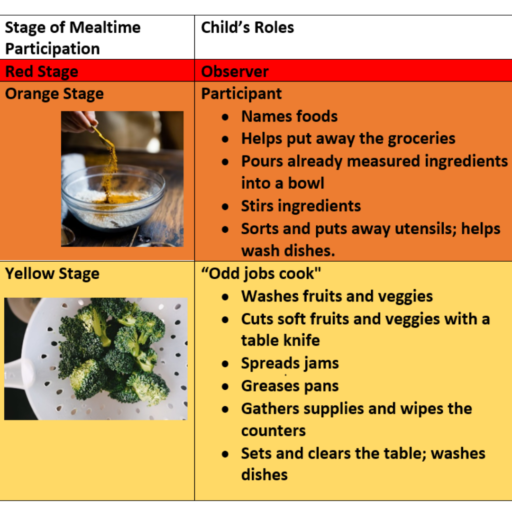

6. Use Food Chaining to determine which foods to introduce in which order.
Know that kids usually choose food that looks like something they’re familiar with (even the packaging) rather than how it tastes until they’re around eight or nine years old. Make a list of the foods your child consistently accepts. Then, write down a food chaining hierarchy to identify which foods to introduce next. Make one small sensory change with each step. You could change the brand, shape, color, flavor, and then texture.
Make sure that all the foods you present link back to all other foods they’re familiar with by some sensory property. For example, is your child’s favorite food potato chips and anything crunchy? Start with something like real vegetable baked potato chips like these, pea crisps like these, or homemade kale chips.
Fill in your own ideas using this Food Chaining Chart:
| Accepted Food | Modify the Aesthetics/Visual (brand, shape or color) | Modify Flavor | Modify Texture | Target Food | Additional modifications to expand accepted foods |
| Potato chips | Different brand of potato chips | Baked veggie chips | Air fried sugar snap peas or kale chips | Raw sugar snap peas or kale | Try with condiments: guacamole, hummus, Thai peanut dipping sauce etc. |
| French fries | Waffle fries (new shape) | Sweet potato waffle fries | Roasted sweet potatoes | Sweet potatoes | Keep modifying to carrots as target food: Roasted sweet potatoes cut in cubes -> roasted carrots cut in cubes -> stir fried carrots (new texture) -> raw carrots (new texture) |
| Muffins | Different brand of muffin Cut muffin into shapes | Oat bran muffins | Oat bran muffins with shredded carrots | Carrots | |
| Crackers | Wheat thins | Spinach wheat thins | Spinach wheat thins dipped in hummus or spinach hummus | Spinach | Shredded spinach mixed into spinach hummus |
| Fritos | Break Fritos up into small pieces | New flavor of Fritos | Stir fried sweet corn topped with crushed Fritos | Corn | Corn chowder Corn in cornbread Dip in chili with beans or baked beans Grilled with vegan butter and salt |
| Pasta with sauce | Pasta with different brand of sauce | Pasta with chunky sauce | Pasta salad with sliced grape tomatoes | Tomatoes |
7. Outside of mealtime, use the Steps to Eating and Clock Method visuals.
Steps to Eating

Outside of mealtime, encourage your child to explore new foods at a pace they’re comfortable with. At first, the goal doesn’t have to be at first to taste or eat the food every time it’s presented but just to engage with it through these steps. Print off one of these charts for each new veggie your child tries. Once they earn a sticker for every square over days or weeks until they have tried it 20-30 times, if they still don’t like it, they can take a break from the food for a while. You can break down the steps even further like this:
- Touch it
- Pick it up
- Smell it
- “Lip Balm” Flavor – Rub your finger on the food and put it on your lips.
- “Finger taste” – Rub your finger on the food and then taste your finger.
- Kiss it
- Lick it
- “Crumbing” – Break up the new food into crumbs and put it on a familiar food; then take a bite.
- Sandwich TRY: This is a new food trying method where the new food is paired with a familiar food to dilute the “ask.” It is a way to pair the new food with a familiar food. An example would be sandwiching a new taste of tomato between two tiny pieces of bread or two crackers. The bread and crackers dilute the smell, flavor and texture “ask.”
- Take a mouse sized > bird sized> dog sized > horse sized > elephant sized bite
- Put it in your mouth (you can spit it out if you need to)
- Put it in your mouth and chew it
- Put it in your mouth and swallow it
The Clock Method

Draw or print a clock. (Laminate for re-use.) Place small bites of foods, alternating between preferred foods and novel/non-preferred food around in a circle. Then, the child chooses a step to eating for each food, moving all the way around the circle. Keep bites small to not overwhelm. When they finish the “clock,” motivate them with a reward.
8. Read books and watch videos about trying new foods.
Infinite resources exist on YouTube! Try watching TV show clips and read-alouds of books that address trying new foods. “Daniel tries a new food,” “The Picky Eater,” “Daniel Tiger’s Neighborhood: Snacktime at Jodi’s House,” “Try a New Food, It Might Taste Good” song, and even videos of animals eating the foods on YouTube. “Listening to My Body” is a great one that talks about why it’s important to eat when you feel hungry to take care of your body. You can also watch videos of animals, other kids or a cartoon eating the target food (like this silly video of a dog eating broccoli).
9. Let them earn creative rewards

Avoid rewarding your child for trying vegetables with desserts. This often does not work and vilifies healthful foods, creating poor relationships with them. Instead, try others forms of rewards. For example, have your child earn beads or charms on a bracelet for each new food tried. Or, create a booklet as a New Foods “Passport.” Here, you draw or write what your child did with a food (e.g. touched it, fed it to the dog, made a craft etc) and put a stamp on it or have them earn a sticker for each new food tried.
10. Most importantly: Play with foods!

Studies like this one indicate that increasing toddlers’ familiarity with fruits and vegetables through play foods promotes increased consumption. Playing with food builds positive relationships with it! Kids eat what they’re familiar with, so don’t give up introducing new foods frequently! A child won’t eat broccoli, for example, if you only bring it out once a week. If you incorporate it into play, they may be more willing to eventually try it.
By engaging in play with food outside of mealtimes (e.g., drawing in hummus, cutting fruits/veggies into fun shapes, building/stacking with food), it takes the stress out and adds fun and exploration. This is a big step in the right direction to eventually accepting new foods. After many opportunities for play with novel and/or non-preferred foods, a child may be more open to licking, biting, or eating it! One general tip: incorporate your child’s interests into games, crafts and play with the new foods. Having a hyper-focused interest can be a doorway to connect with them.
Here are some ideas for playing with fruits and vegetables:
Messy play
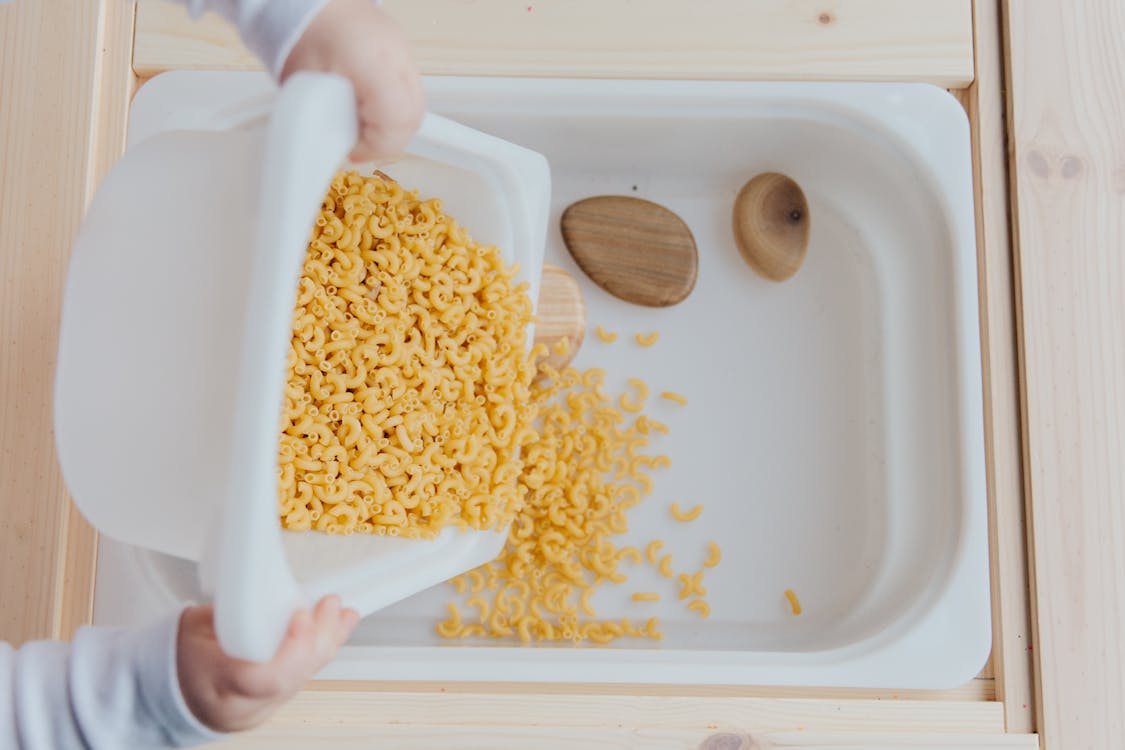
- Grab a plastic bin, cooked vegetables and your child’s favorite toys and play in the bin. Let your child mash and squish the vegetables without any pressure to taste it at first. This allows them to explore the foods with all their senses. For example, use the broccoli in a sensory box for play and have it be a tree. Make “volcanoes” out of sweet potatoes for toy dinosaurs to go into, then lick the food off the dinosaurs. Lay out green beans as train tracks on plates for Thomas the Train. Push veggies around in a bin with toy trucks. Try also using play food and playing with food away from the table.
- Finger paint on the plate or on a paper (e.g. with liquids, condiments, smoothies etc.).
- Set your child up in front of a mirror and do face painting with the food (e.g. pureed foods like applesauce, pureed veggies etc.) with the goal of getting the foods closer and closer to child’s lips and tongue.
- For younger kids: Pretend to sneeze the food off your head, then nose, then mouth; then have child take a turn, getting the food closer and closer to lips and tongue each time. Or, “Boop”/tap foods on their body and face, getting closer and closer to your child’s mouth as tolerated.
Crafts
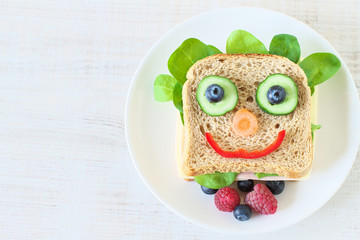
- Draw a smiley face, large letters, shapes or anything else your child is interested in on paper and have your child fill in the shape with pieces of vegetables. Laminate for re-use. Afterwards, tap each food going “jump jump squish” to explore the texture and see what’s inside.
- Make animal faces on bread, toast or tortillas with a spread like peanut butter and fruit or veggies.
- Sort vegetables by color into cups in rainbow order or count out pieces of the vegetables into cups labeled 1-10.
- Make a rainbow, tower or a popsicle (simply by putting it on a toothpick and licking it like a popsicle). Parent builds towers and child knocks them over, then child builds towers.
- Put stickers on the foods.
- Cut out shapes from the veggies with cookie cutters.
- Sort by shapes of the foods.
- Make into shapes (put pieces on outlines) or pictures (house, car)
- Paint with it (e.g. half an apple or raw potato as a stamp)
Games

- Choose a preferred game. To “earn” each turn, the child chooses a step to eating.
- Flick it into a “soccer goal.”
- Spin a spinner and engage in Steps to Eating for the food it lands on.
- Play Candy Land and set up different foods on each stop. Where it lands is what you try.
- Act out feeding foods to a toy, parent, or a laminated mat with a preferred image.
- Take pictures or videos of child doing the steps to eating.
- Pretend to be different animals and eat the vegetables those animals would eat (e.g. bunny eating carrots etc).
- Food popping (blow the food as far as you can from your mouth)
- Set a visual timer (Countdown app is free) and see how many foods you can taste/bites you can take before the clock runs out!
- Let your child watch a preferred TV show as long as she or he continues licking, biting and spitting out or chewing the foods.
- “Crunch contest”: You both bite the same food and see who can make the loudest crunch.
- For vegetables served as liquids (eg soups, pouches, purees): give figurines a “bath” in it, blow bubbles in it through a straw, dip your finger in it to finger paint, or play puppies and lap it up from a bowl alongside some toys.
How to get toddlers to eat vegetables with 10 proven strategies
To recap how to get toddlers to eat vegetables: 1) cook and bake vegetables so they are sweet, “dressed up” as familiar foods,” or “hidden” in kid-friendly dishes; 2) use positive language around trying new foods and your child’s food habits; 3) implement mealtime strategies of family-style meals, varying your environment, serving veggies first, offering least one safe food, ensuring comfortable positioning; 4) know your mealtime roles.
Furthermore, 5) get kids involved in prep using the Rainbow Stages of Mealtime Participation; 6) use food chaining; 7) use the Steps to Eating and Clock Method; 8) read books and watch videos about trying new foods, 9) let your kids earn rewards and 10) most importantly, play with new foods through messy play, crafts and games.
